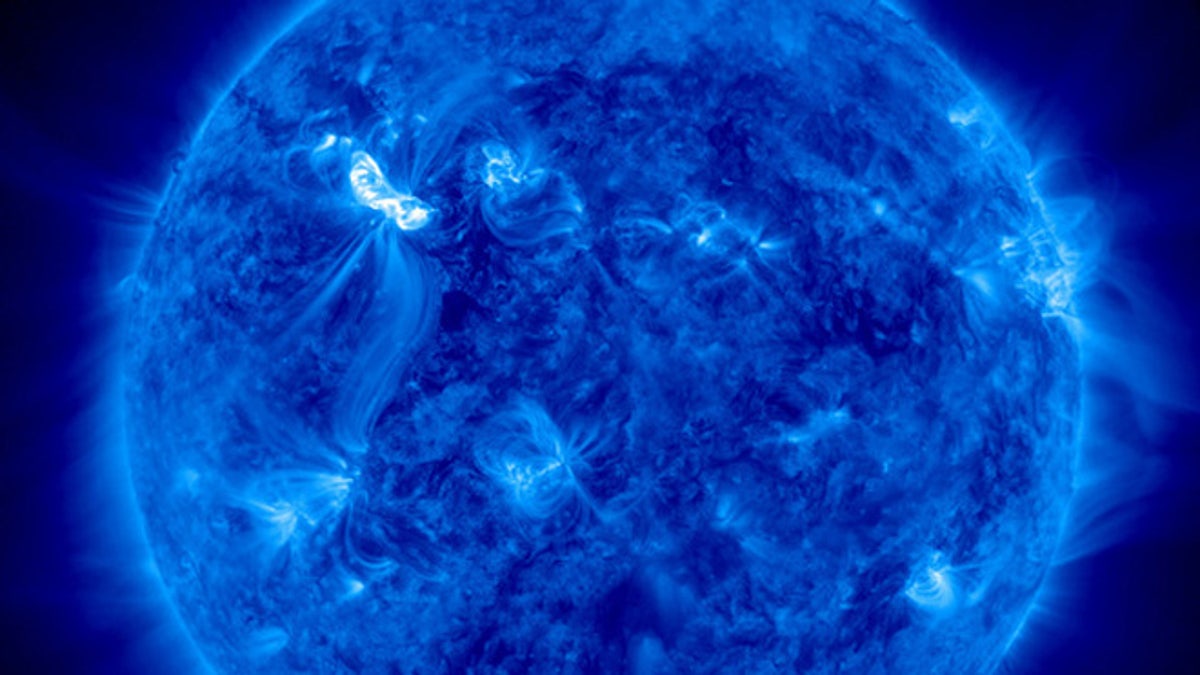
March 6, 2012: NASA's Solar Dynamics Observatory captures the sun as it unleashed an X5.4-class solar flare at 7:04 p.m. EST. The flare appears as the bright spot in the upper left. (NASA/SD)
A massive solar storm arrived at Earth early Thursday, and is expected to shake the globe's magnetic field until early Friday morning, while expanding the Northern Lights.
A giant blast of plasma spat from the sun at as much as 4 million miles per hour Tuesday -- by some measures the largest solar event since late 2006 -- and it could lead to serious issues on Earth, forcing some planes to reroute, knocking out power grids, and blacking out radios.
The sun unleashed the cosmic double whammy late March 6, erupting with two major flares to cap a busy day of powerful solar storms, Space.com reported. One of the flares is the most powerful solar eruption so far this year.
“Super Tuesday? You bet!” joked Joseph Kunches, a space weather scientist with the National Oceanic and Atmospheric Administration (NOAA).
The storm grew as it raced outward from the sun, expanding like a giant soap bubble, scientists said. Its initial effects arrived at the Earth early Thursday morning at about 5:45 a.m. EST, according to NOAA's Space Weather Prediction Center.
"It's hitting us right in the nose," Kunches had predicted Wednesday. The blow appears to be more of a a glancing one that will interact with the Earth's magnetic field throughout the day.
Both of the huge flares ranked as X-class storms, the strongest type of solar flares the sun can have. They followed several weaker, but still powerful, sun storms on Tuesday and came just days after another major solar flare on Sunday night.
“By some measures this is the strongest one since December of 2006,” Kunches explained. Solar activity has already led to an R3 level radio blackout on NOAA’s space weather scale, he explained, a midstrength event on a scale that reaches to R5. Such effects are caused by X-ray emissions from the sun.
The bigger effects will hit the planet over the next 24 hours.
[pullquote]
For one thing, geomagnetic storms -- disturbances in the geomagnetic field that surrounds the planet -- should hit the G3 level, midway up the scale. That could lead to surges in power lines (a major problem for power companies) and issues with satellites.
“Power grid operators have all been alerted, as well as the regulatory agencies that all pay attention to this,” Kunches said.
GPS users will also be affected because of the highly charged atmosphere; it’s very possible that certain types of applications will be interrupted, specifically highly precise calculations and the high-frequency communications that airplanes rely upon.
Indeed, some polar flights have already been affected, he said.
“Some have already taken action to reroute to ensure their [high-frequency communication],” Kunches said.
Solar radiation storms could reach as high as S4, he noted, which could cause astronauts on the International Space Station to seek shelter from the heightened radiation levels associated with such a storm.
These effects should last about 24 hours, probably lingering overnight into the early morning hours on Friday, pending another eruption -- “and we think there will be more coming,” Kunches said.
The upside? Some areas may experience a wonderful display of the Northern Lights.
“It’s the treat that we get when the sun erupts,” he said.
The Associated Press contributed to this report.
